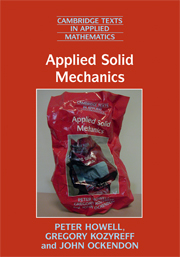Book contents
Epilogue
Published online by Cambridge University Press: 02 February 2010
Summary
There are three main themes to this book.
In Chapters 1–5, we have provided an elementary exposition of the basic concepts in classical solid mechanics, namely linear elasticity, elastostatics, elastodynamics, models for thin structures and nonlinear elasticity. In each case, we have focused on practical examples that highlight the most interesting modelling and mathematical issues.
In Chapter 6, our aim was to show how formal perturbation methods, widely used in fluid dynamics, can be applied to many problems in solid mechanics involving bodies that are thin or slender. Although the remainder of the book does not rely on this chapter, we firmly believe that the techniques demonstrated there form an invaluable component of any applied mathematician's armoury.
Finally, in Chapters 7–9, we have given necessarily brief introductions to some of the important physical situations where classical solid mechanics fails, and the elementary theories from Chapters 1–5 must be re-examined. Inevitably, the mathematical problems involved here become more challenging, and we have therefore limited our attention to idealised models that clearly illustrate the fundamental concepts.
The diversity and open-endedness of the topics described in Chapter 9 reflect the fact that we have not done justice to many scientific ideas in theoretical solid mechanics. Fracture, plasticity and viscoelasticity, for example, are subjects of enormous practical importance, and there are many texts describing both the practical and the mathematical aspects in much greater detail than the contents of Chapters 7–9.
- Type
- Chapter
- Information
- Applied Solid Mechanics , pp. 426 - 427Publisher: Cambridge University PressPrint publication year: 2008

